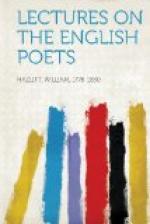“A Monk
there was, a fayre for the maistrie,
An out-rider,
that loved venerie:
A manly man, to
ben an abbot able.
Ful many a deinte
hors hadde he in stable:
And whan he rode,
men mighte his bridel here,
Gingeling in a
whistling wind as clere,
And eke as loude,
as doth the chapell belle,
Ther as this lord
was keper of the celle.
The
reule of Seint Maure and of Seint Beneit,
Because that it
was olde and somdele streit,
This ilke monk
lette olde thinges pace,
And held after
the newe world the trace. [*]
He yave not of
the text a pulled hen,
That saith, that
hunters ben not holy men;—
Therfore he was
a prickasoure a right:
Greihoundes he
hadde as swift as foul of flight:
Of pricking and
of hunting for the hare
Was all his lust,
for no cost wolde he spare.
I
saw his sleves purfiled at the hond
With gris, and
that the finest of the lond.
And for to fasten
his hood under his chinne,
He had of gold
ywrought a curious pinne:
A love-knotte
in the greter end ther was.
His hed was balled,
and shone as any glas,
And eke his face,
as it hadde ben anoint.
He was a lord
ful fat and in good point.
His eyen stepe,
and rolling in his hed,
That stemed as
a forneis of a led.
His botes souple,
his hors in gret estat,
Now certainly
he was a fayre prelat.
He was not pale
as a forpined gost.
A fat swan loved
he best of any rost.
His palfrey was
as broune as is a bery.”
___ [*] PG transcriber’s note: “space” instead of “trace” in some editions. ___
The Serjeant at Law is the same identical individual as Lawyer Dowling in Tom Jones, who wished to divide himself into a hundred pieces, to be in a hundred places at once.
“No wher
so besy a man as he ther n’as,
And yet he semed
besier than he was.”
The Frankelein, in “whose hous it snewed of mete and drinke”; the Shipman, “who rode upon a rouncie, as he couthe”; the Doctour of Phisike, “whose studie was but litel of the Bible”; the Wif of Bath, in
“All whose
parish ther was non,
That to the offring
before hire shulde gon,
And if ther did,
certain so wroth was she,
That she was out
of alle charitee;”
—the poure Persone of a toun, “whose parish was wide, and houses fer asonder”; the Miller, and the Reve, “a slendre colerike man,” are all of the same stamp. They are every one samples of a kind; abstract definitions of a species. Chaucer, it has been said, numbered the classes of men, as Linnaeus numbered the plants. Most of them remain to this day: others that are obsolete, and may well be dispensed with, still live in his descriptions of them. Such is the Sompnoure:




